How Arab-Chinese Cooperation Could Impact the Global Energy Transition
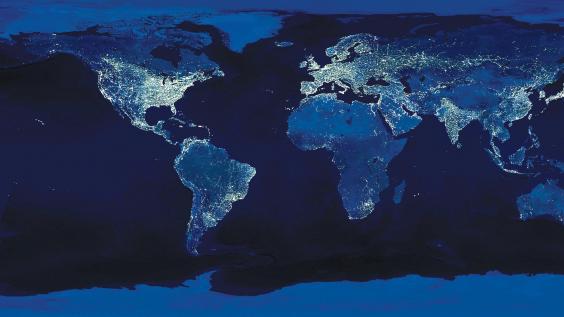
Table of Contents
Author(s)
Share this Publication
- Print This Publication
- Cite This Publication Copy Citation
Osamah Alsayegh, "How Arab-Chinese Cooperation Could Impact the Global Energy Transition" (Houston: Rice University’s Baker Institute for Public Policy, December 7, 2022), https://doi.org/10.25613/2KY8-6B65.
Introduction
The Kingdom of Saudi Arabia recently announced through its foreign minister, Faisal Bin Farhan,[1] and the minister of state for foreign affairs, Adel Al-Jubeir,[2] that it will host three summits with Chinese President Xi Jinping in Riyadh, Saudi Arabia, in early December 2022. The events will include the Saudi-Chinese, Gulf Cooperation Council (GCC)-Chinese and Arab League-Chinese Summits. Saudi officials have indicated that the meetings will focus on regional and global stability and security, investment opportunities, energy and climate change.
The past few years have already seen deepening economic connections between China and the Arab world. For example, trade between the Arab states and China reached US $134 billion in 2020 versus US $10.9 billion in 2000,[3] and accumulative investments reached $190 billion between 2005 and 2022.[4] The Arab region is also China’s primary source for oil and natural gas. China’s oil and gas imports grew significantly in the past two decades. Its oil imports increased from 2.0 million barrels per day in 2000, which represented 4% of the world’s imports, to 12.9 million barrels per day in 2020, which constituted 20% of the world’s total imports. Similarly, gas imports rose from 1.0 billion cubic meters in 2006, which made 0.5% of the world’s imports, to 94 billion cubic meters in 2020, which signified 19.0% of the world’s imports.5 In 2020, China’s crude and oil products imports of about 5.5 million barrels of oil equivalent (boe) per day and gas imports of 13.4 billion cubic meters from Arab countries amounted to roughly 43% and 14% of its total imports, respectively.[5] In comparison, in 2005 its gas imports were negligible.[6] With such vital mutual interests, Arab and Chinese leaders are expected to coordinate on an array of challenges — including energy and climate change — at the upcoming summits.
This issue brief highlights the potential collaboration between Arab countries and China in dealing with the global energy transition, and examines the energy transition from the perspectives of the world's largest economy (China) and richest hydrocarbon region (the Middle East).
Grounds for Cooperation
Both the Arab world and China have economic ambitions and political goals that could benefit from deeper collaboration. Bilateral trade between the Arab states and China is higher than trade between the Arab states and the world’s other large economies, e.g., the US, Germany and India (Figure 1). Although the COVID-19 pandemic slowed trade around the globe, the average trade growth rate between Arab nations and China stayed positive at 1.3% for 2015-2020, whereas the region had a declining growth rate with other economic giants over the past five years.[7]
Furthermore, the Middle East and North Africa region, which includes most of the Arab states, is vital for China’s Belt and Road Initiative (BRI). The objective of the BRI is to establish trading routes connecting China with the rest of the world. It involves massive infrastructure investments to serve its purpose, and Chinese investments in the region have grown rapidly (Figure 2). The average growth rate of five-year accumulated investments from the period of 2005-2010 to 2017-2022 was 40%. Moreover, the growth rate of accumulated investments from 2005 to 2022 in the GCC region was more than 60% — with 26% in Saudi Arabia.
The BRI is considered an opportunity for Arab countries, particularly the GCC countries, to diversify their economies beyond hydrocarbons. Sixteen Arab countries, including the six GCC countries, have signed the BRI’s memorandum of understanding.[8] The details of the memorandum of understanding may differ from one country to another, but the general objectives remain the same: “(i) to promote connectivity of policy, infrastructure, trade, finance, and people (ii) to seek new opportunities in cooperation to achieve common development, (iii) to strive to develop an open global economy, jointly, (iv) to combat global challenges and promote the building of a common future.”[9] For China, its presence in the region assures the security of its supply routes and, hence, the sustainability of its economic growth.
Figure1 — Bilateral Trade Between the Arab World and the World's Largest Economies
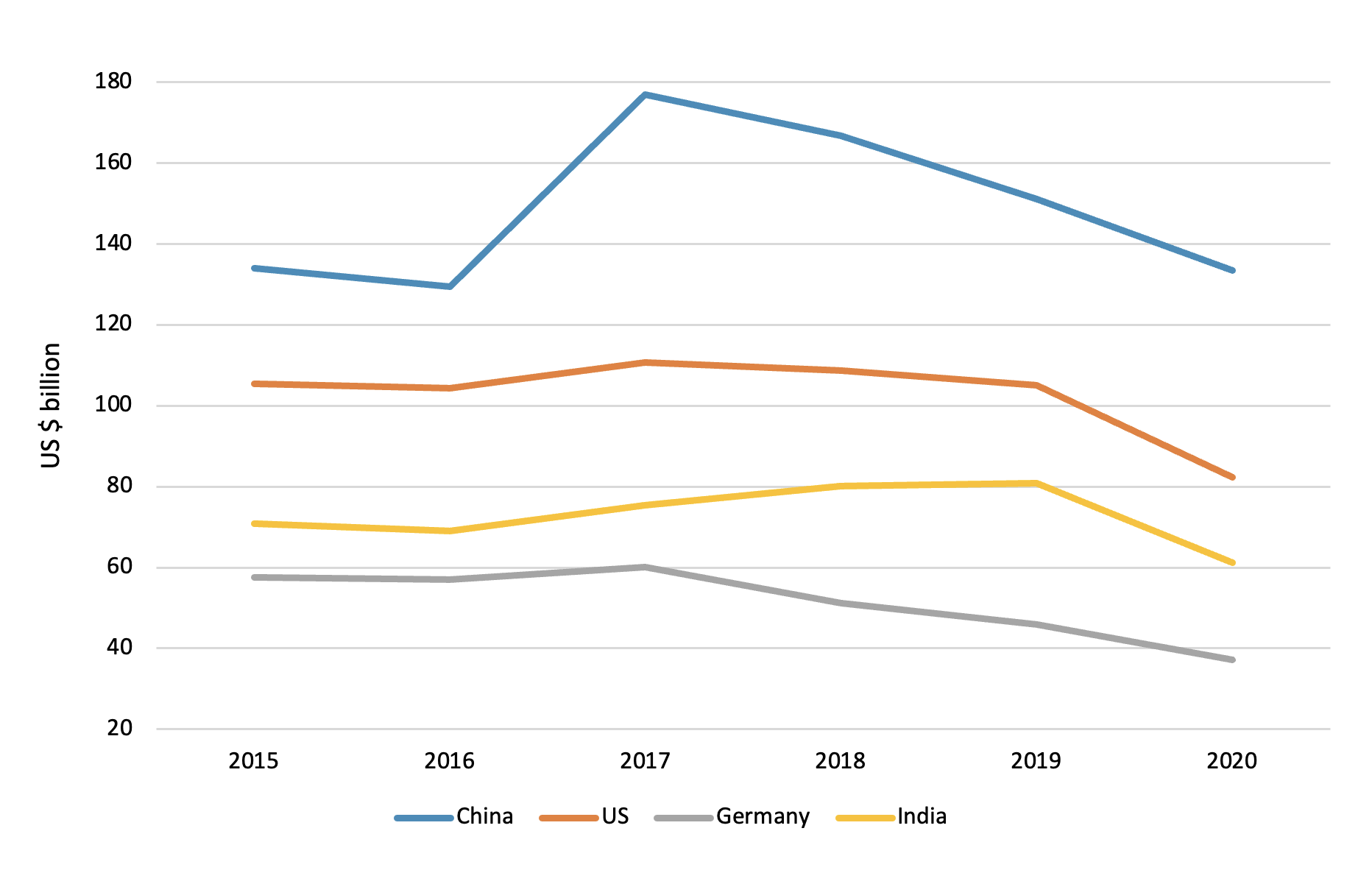
Figure 2 — Chinese Investments in the Arab World
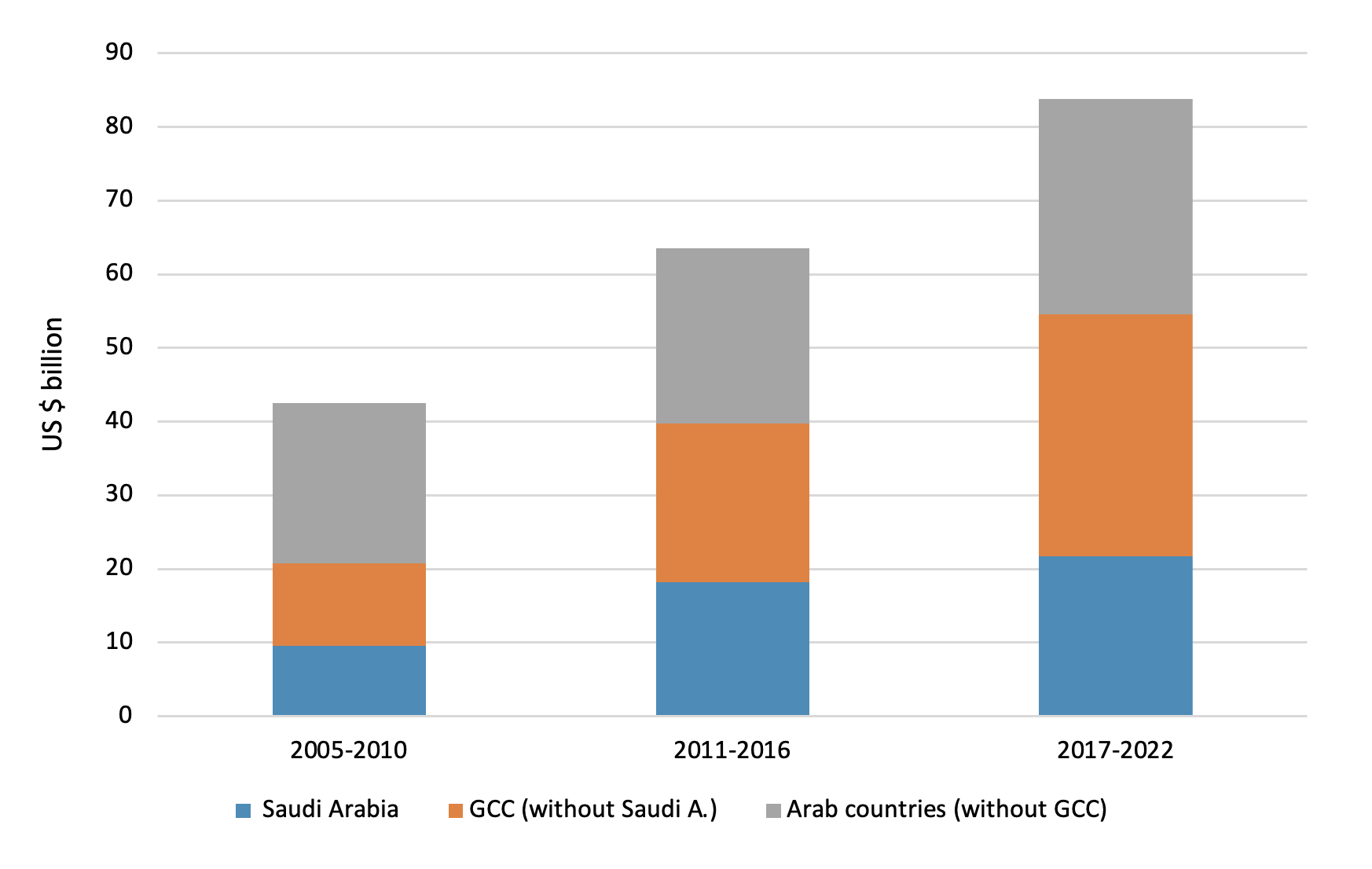
Moreover, both the Arab world and China share an interest in securing the supply and demand of hydrocarbon resources. In 2020, China received 2.0 billion barrels of oil equivalent of crude and oil products (constituting 43% of its total demand) and 13.4 billion cubic meters of natural gas (comprising 14% of its total demand) from Arab nations, mainly GCC countries (Figure 3). China’s refining capacity is almost 17.0 million barrels per day, and it is expected to reach 18.8 million barrels per day by 2023, which would give it the world’s largest capacity.[10] Arab oil- and gas-producing countries therefore view China’s substantial demand for hydrocarbon commodities as a significant opportunity to monetize their hydrocarbon assets.
Given its economy's large size and aim to grow, phasing out oil and gas from China’s energy and non-energy sectors will not be realized for at least three decades, though China’s electric vehicle and renewable electricity production imply that oil and gas consumption in China may eventually peak and decline before 2050. However, this could pave the way for a common strategy between Arab oil and gas producers and China for taking on the energy transition.
Figure 3 — China’s Imports of Hydrocarbons From the Arab World in 2020
(a) Level of Crude and Oil Products Import and Its Percentage Relative to Total Demand
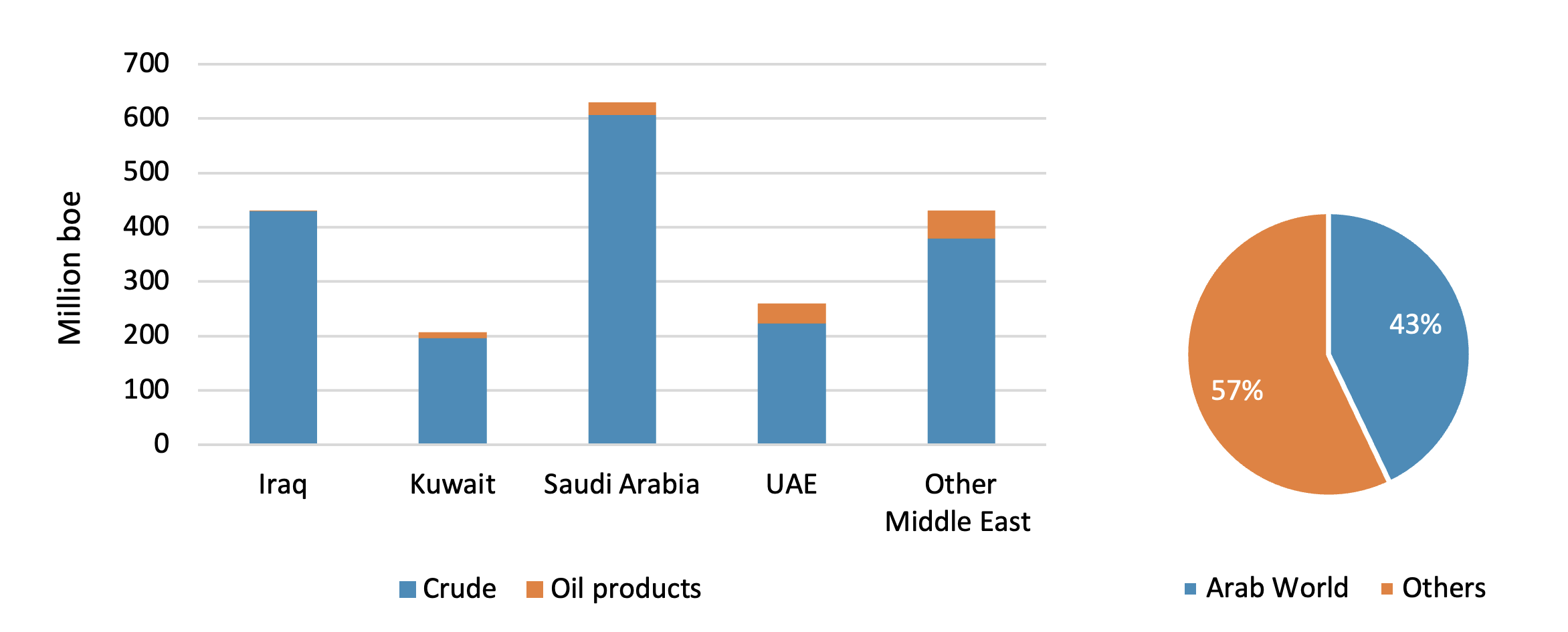
(b) Level of Natural Gas Import and Its Percentage Relative to Total Demand
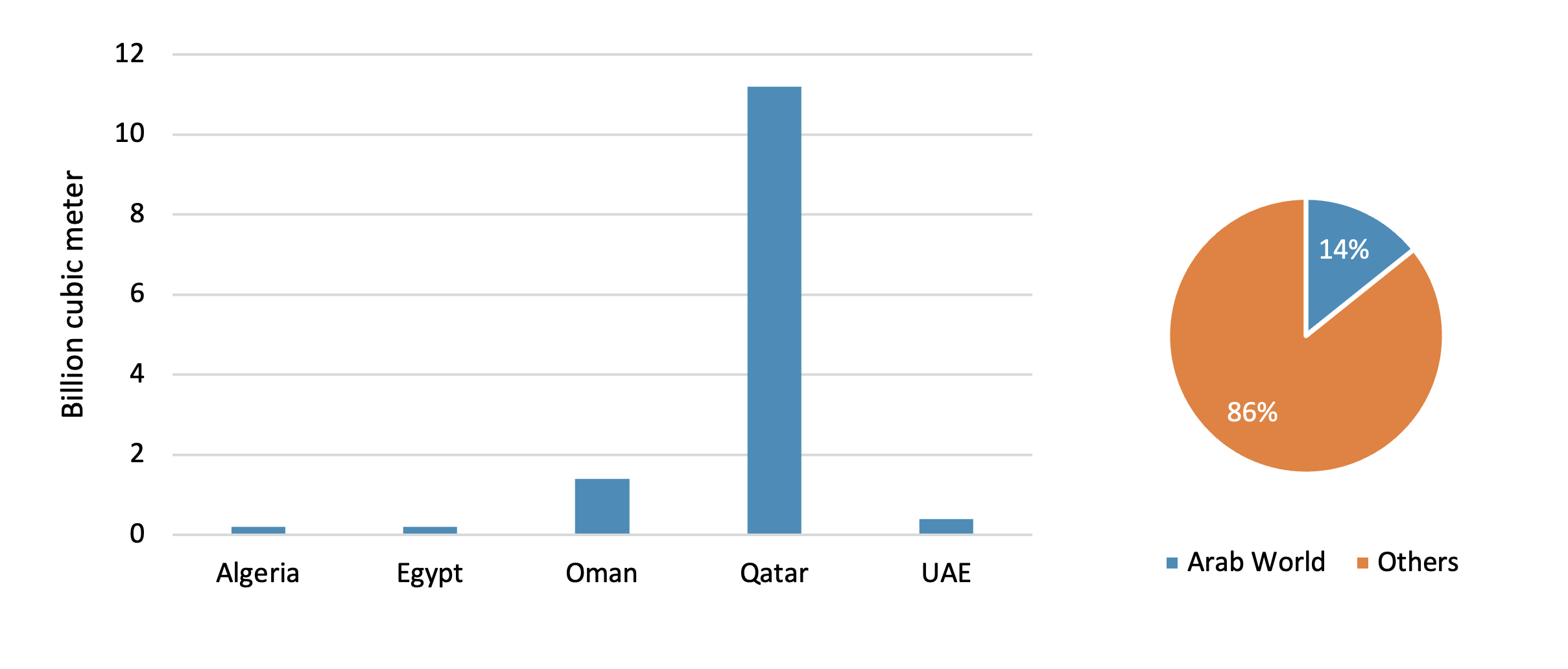
Common Vision for Taking on the Energy Transition
When US President Joe Biden attended the Jeddah Summit for Security and Development in Saudi Arabia in July 2022 to meet with leaders of the six GCC countries as well as Iraq, Egypt and Jordan, Saudi Crown Prince Mohammad Bin Salman expressed the Arab oil and gas producers’ general goals for the energy transition. These included: (i) adopting a balanced approach — through a gradual and responsible transition toward more sustainable energy sources and emissions mitigation — that avoids exacerbating inflation, unemployment, and social and security problems while keeping energy prices low; (ii) integrating clean technologies with the hydrocarbon industrial systems; and (iii) investing in fossil fuels while also encouraging the development of clean energy technologies in the next two decades.[11]
In a recent statement in October 2022, Chinese President Xi Jinping asserted that “China will not rush its clean energy transformation.” In his speech before the 20th National Congress of the Chinese Communist Party, President Xi promised a slow and steady end to the growth of emissions in China, while also making it clear that China “will not stop burning fossil fuels until it’s confident that clean energy can reliably replace them.”[12] It’s clear that China shares a similar perspective with Arab oil- and gas-producing countries in regard to their energy transition strategies. Both China and the Arab nations aim to (i) continue exploiting oil and gas to stabilize domestic and world economies, and (ii) integrate clean technologies with oil and gas sectors to mitigate carbon emissions. The second point — the integration of clean technologies — is a major component of both Chinese and Arab strategies to achieve near-zero carbon emissions.
Pursuing the Energy Transition
Arab and Chinese officials are both aware of the significance and need to integrate sustainable energy as a fundamental element of their national development policies. So far, efforts to ensure that energy is used and produced in ways that are sustainable and environmentally conscious have varied from country to country. These efforts are officially reported in national communication reports, which are submitted to the United Nations Framework Convention on Climate Change.[13] Several Arab countries have announced their visions for pursuing net-zero carbon emissions (mainly Scope 1 emissions). For instance, in its Vision 2030, Saudi Arabia stated its aim of accelerating the energy transition, achieving sustainability goals and reaching net-zero emissions by 2060.[14] Similarly, the UAE asserted its plan to achieve net-zero emissions by 2050,[15] and other Arab countries have pledged to mitigate emissions by certain percentages.[16]
China emits 27% of global carbon dioxide and a third of the world’s greenhouse gases.[17] It has pledged through its “nationally determined contribution” to reach peak carbon emissions by 2030 and reduce the country’s carbon intensity by over 65% in 2030 from 2005 levels.[18]
To achieve these goals, China and Arab states will not immediately abandon the production and use of oil and gas. Instead, their energy transition strategies are based on three pillars: (i) energy efficiency and demand management, (ii) diversification of the energy supply mix, and (iii) carbon emission mitigation management.
Improving energy efficiency could contribute massively toward mitigating carbon emissions. If energy efficiency were enhanced across demand sectors — including industry, buildings and transportation — in both China and the Arab world, the impact on carbon emissions would be drastic. Given China’s manufacturing capacity and Arab states’ financial investment strength, these nations could cooperate to develop technologies and processes with improved energy-intensity ratings. Arab states could also learn from the Chinese experience in overcoming implementation difficulties, blending market-based energy efficiency investment and service mechanisms, and investing in institutional development to provide the foundation for long-term gains.[19]
Arab leaders also have ambitious plans to include clean energy systems — i.e., renewables, nuclear and hydrogen — into their energy mix. The total installed renewable energy capacity in all Arab countries is more than 18.0 gigawatts, which constitutes about 10% of the total installed capacity.[20] The UAE is the most active Arab country with functional renewable and nuclear energy systems and a total installed capacity of more than 517 megawatts (MW) of renewables[21] and 2690 MW of nuclear technology.[22] Saudi Arabia currently leads the Arab states in clean hydrogen production, or so-called “blue hydrogen.” Saudi Aramco and Saudi Basic Industries Corporation (SABIC) have partnered to capture carbon emissions from the hydrogen production process and are converting around 80% of their hydrocarbon energy into hydrogen fuel. In 2020, they shipped 40 tons of high-grade blue ammonia (a compound of nitrogen and hydrogen) to Japan for energy use in power stations.[23] Other Arab countries, especially GCC countries, have ambitions to explore and invest in the hydrogen supply chain — from production and transportation to end use.[24]
On the other side, China is the world leader in renewable energy system production, including wind and solar energy technologies. It owns five of the world’s six largest solar-module manufacturing companies and the world’s largest wind turbine manufacturer. Moreover, China is the largest domestic and international investor in renewable energy.[25] In the case of hydrogen production, China is active in supporting fuel cell vehicle (FCV) deployment and producing renewable-based hydrogen. It has the largest hydrogen production capacity and is among the world's largest markets for FCVs.[26] China is also working to advance its nuclear technology for power applications to counter the growing carbon emissions from its coal-fired plants. It has become self-sufficient in reactor design and construction, as well as fuel cycle. China’s aim is to export its nuclear technology — including reactor pressure vessels, turbines, and generators — in the global supply chain.[27]
In general, renewables, hydrogen and nuclear technologies are key areas of potential collaboration between Chinese and Arab officials that could help both to achieve their energy transition and environmental goals. Additionally, carbon capture, storage and utilization is the primary technology supporting Arab and Chinese energy transition strategies. The Chinese oil company and chemical manufacturer Sinopec has established the world’s largest carbon capture facility with the ability to capture 1.0 million metric tons of carbon dioxide per year.[28] China’s experience in carbon capture could help inform the Arab world as it too attempts to transform its fossil fuel-based sectors into environmentally friendly facilities.
Conclusion
Given their growing economic and energy trade interrelations, China and oil- and gas-producing Arab states share a common understanding of the energy transition and how to achieve net-zero carbon emissions. Despite recent announcements of reducing carbon emissions to near zero (or zero) levels, fossil fuels will continue to be part of their energy system mix for the foreseeable future. Both Chinese and Arab leaders are seeking a gradual transition that won’t jeopardize their local economies. Hence, adopting energy demand management strategies, deploying clean alternative energy systems and working to mitigate carbon emissions are the key strategies being pursued.
The upcoming Saudi-Chinese, GCC-Chinese and Arab League-Chinese summits in early December in Riyadh will reveal the extent to which China and the Arab nations cooperate on these issues. Officials are expected to discuss potential plans for a range of areas including energy efficiency technologies and measures; renewable energy deployment; blue and green hydrogen supply chain development; nuclear power usage; carbon capture, storage and utilization (CCSU) development and integration with fossil fuel facilities; and the non-energy use of hydrocarbon products. It remains to be seen whether Chinese and Arab officials will succeed in finding common ground on these many areas and what the implications will be for the global energy transition.
Endnotes
[1] Saudi Gazette, “Saudi Arabia to host 3 summits during Chinese President Xi’s visit,” Zawya, October 27, 2022, https://www.zawya.com/en/economy/gcc/saudi-arabia-to-host-3-summits-during-chinese-president-xis-visit-j5asxaq6.
[2] Aidan Lewis and Sarah El Safty, “Trade and security on agenda for Xi visit to Saudi Arabia, Saudi minister says,” Reuters, November 12, 2022, https://www.reuters.com/business/cop/trade-security-agenda-xi-visit-saudi-arabia-saudi-minister-2022-11-12/.
[3] World Integrated Trade Solution, World Bank, 2022.
[4] “China Global Investment Tracker,” American Enterprise Institute, accessed November 23, 2022, https://www.aei.org/china-global-investment-tracker/.
[5] “Statistical Review of World Energy - 70th Edition,” British Petroleum, London, UK, 2021.
[6] Hannah Reale, Emma Bingham, and Kara Greenberg, “Where Does China Get Its Oil?,” The Wire China, July 12, 2020, https://www.thewirechina.com/2020/07/12/where-does-china-get-its-oil/.
[7] World Integrated Trade Solution, World Bank, 2022.
[8] “Countries of the Belt and Road Initiative,” The Green Finance & Development Center, accessed November 23, 2022, https://greenfdc.org/countries-of-the-belt-and-road-initiative-bri/.
[9] MOU between the Government of The State of Victoria of Australia and the National Development and Reform Commission of The People's Republic of China on Cooperation Within the Framework of the Silk Road Economic Belt and the 21st Century Maritime Silk Road Initiative, 2018, https://www.vic.gov.au/sites/default/files/2019-02/Belt-and-Road-Initiative-MOU.pdf.
[10] “Crude oil refinery capacity in China from 1970 to 2021,” Statista, accessed November 25, 2022, www.statista.com.
[11] “Jeddah Summit for Security and Development - Messages from the Saudi Crown Prince on Oil, Gas and Climate Change,” Attaqa, July 16, 2022, www.attaqa.net.
[12] “China Won’t Stop Using Fossil Fuels Until Clean Sources Can Provide Enough Energy Security,” TIME, October 17, 2022, https://time.com/6222566/china-fossil-fuel-plan-xi-jinping/.
[13] “State of Kuwait Second National Communication,” Kuwait Environment Public Authority, Kuwait, 2019.
[14] “A Sustainable Saudi Vision,” Kindom of Saudi Arabia, accessed November 25, 2022, https://www.vision2030.gov.sa/v2030/a-sustainable-saudi-vision/.
[15] “The UAE's Response to Climate Change,” United Arab Emirates, accesssed November 25, 2022, https://u.ae/en/information-and-services/environment-and-energy/climate-change/theuaesresponsetoclimatechange.
[16] “Environment and Sustainability,” State of Qatar, accessed Novmeber 25, 2022, https://www.gco.gov.qa/en/focus/environment-and-sustainability/; Kuwait Vision 2035 “New Kuwait,” Ministry of Foriegn Affairs, State of Kuwait, accessed November 25, 2022, https://www.mofa.gov.kw/en/kuwait-state/kuwait-vision-2035/.
[17] “China’s Transition to a Low-Carbon Economy and Climate Resilience Needs Shifts in Resources and Technologies,” World Bank, October 12, 2022, https://www.worldbank.org/en/news/press-release/2022/10/12/china-s-transition-to-a-low-carbon-economy-and-climate-resilience-needs-shifts-in-resources-and-technologies.
[18] Swithin Lui, “Guest post: Why China is set to significantly overachieve its 2030 climate goals,” Carbon Brief, May 19, 2022, https://www.carbonbrief.org/guest-post-why-china-is-set-to-significantly-overachieve-its-2030-climate-goals/.
[19] “China: 40-Year Experience in Energy Efficiency Development - Policies, Achievements, and Lessons Learned,” World Bank, Washington DC, 2021.
[20] M. Mahmoud and A. Habib, “Arab Future Energy Index 2019,” Regional Center for Renewable Energy and Energy Efficiency, Cairo, Egypt, 2019.
[21] “Energy Profile - United Arab Emirates,” International Renewable Energy Agency, Abu Dhabi, UAE, 2022.
[22] Emirate Nuclear Energy Corporation, accessed November 25, 2022, https://www.enec.gov.ae/.
[23] “How can we deliver one of the fuels of the future?,” Aramco, 2022, bit.ly/3Fx2RM0.
[24] C. Heinemann, D. Ritter, R. Mendelevitch and K. Dünzen, “Hydrogen fact sheet – Gulf Cooperation Countries,” Institute for Applied Ecology, Freiburg, Germany, 2022.
[25] Dominic Chiu, “The East Is Green: China’s Global,” New Perspectives in Foreign Policy, Center for Strategic and International Studies, no. 13, 2017, https://www.csis.org/east-green-chinas-global-leadership-renewable-energy.
[26] J. Nakano, "China’s Hydrogen Industrial Strategy," Center for Strategic and International Studies, February 3, 2022. https://www.csis.org/analysis/chinas-hydrogen-industrial-strategy.
[27] “Nuclear Power in China,” World Nuclera Associate, November 2022, https://world-nuclear.org/information-library/country-profiles/countries-a-f/china-nuclear-power.aspx.
[28] Michael McCoy, “Sinopec completes China’s first large carbon capture plant,” Chemical & Engineering News 100, no. 5, February 4, 2022, https://cen.acs.org/articles/100/i5/Sinopec-completes-China-first-large-carbon-capture-plant.html.
This material may be quoted or reproduced without prior permission, provided appropriate credit is given to the author and Rice University’s Baker Institute for Public Policy. The views expressed herein are those of the individual author(s), and do not necessarily represent the views of Rice University’s Baker Institute for Public Policy.



